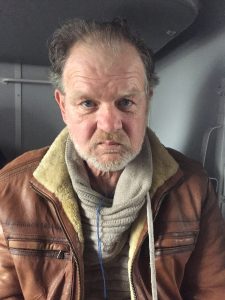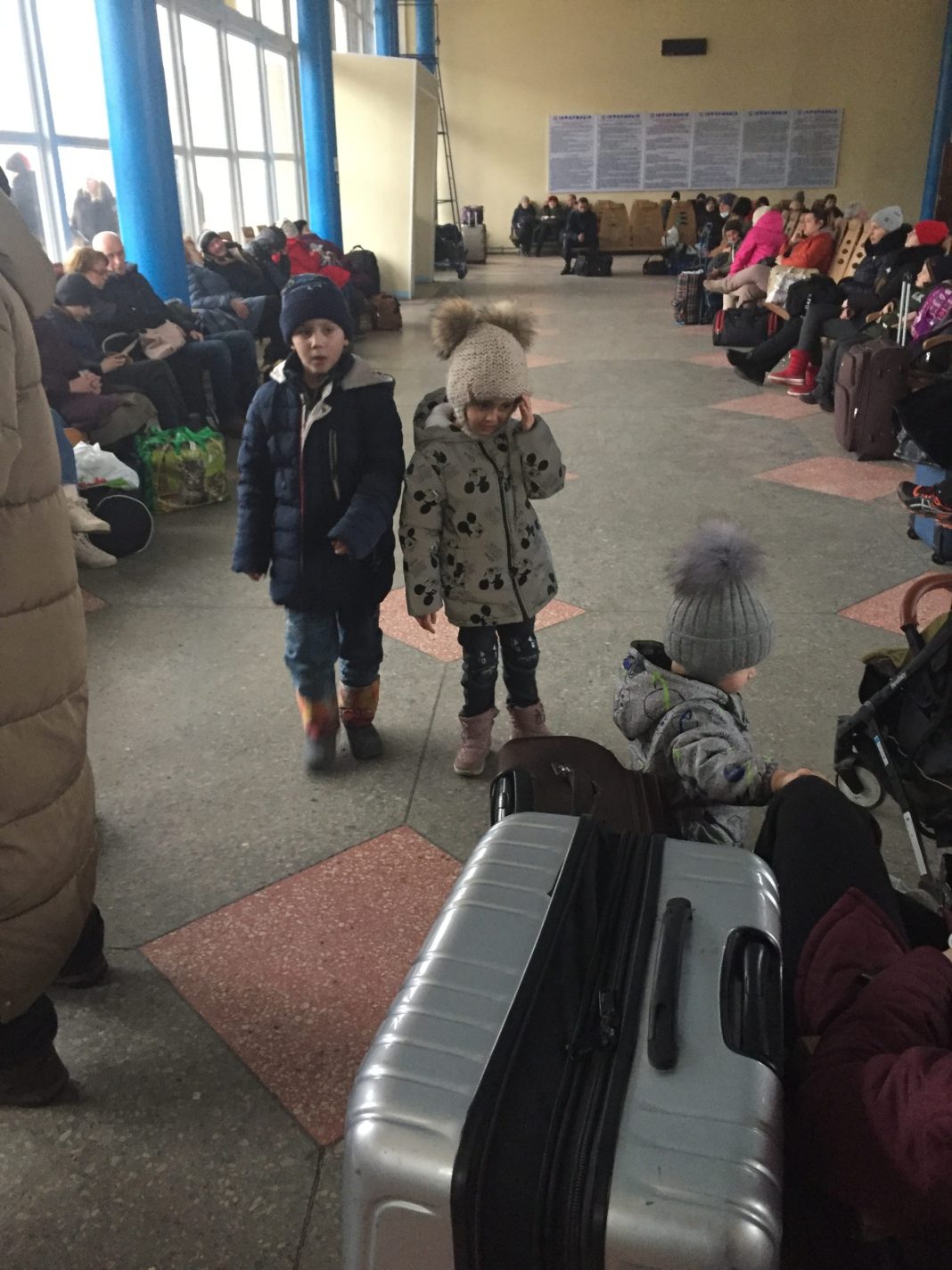Lviv, Ukraine 2 March 2022
by Askold Krushelnycky
Last week Kremlin leader Vladimir Putin declared the pro-Moscow entities independent republics and used the pretext of “liberating” them from fictional Ukrainian Government genocide against Russian speakers to launch his invasion. Hundreds of evacuees, mostly women and children, were marooned at Lysychansk railway station, near the main Ukrainian-held city of Severodonetsk, because Russian shelling had destroyed some of the track between them and the train which had been scheduled to pick them up at 4pm last Friday.
Lysychansk Railway station in Luhansk province: Ukrainian refugees are fleeing the war that has engulfed their country. They are facing increasingly horrific and dangerous conditions as the number of escape routes dwindle. Luhansk and neighbouring Donetsk Province have been partly-occupied by Moscow’s puppet “separatist” forces since the Kremlin first invaded Ukraine in 2014.
Most people are heading westward, with the city of Lviv still viewed as a safe haven on the way to European Union countries. But that may soon change. According to Ukrainian military intelligence 300 Belarus tanks are ranged next to the border, 110km north if Lviv, awaiting orders from their murderous Russian masters. The UN says more than 600,000 civilians have fled Ukraine and the EU estimates that up to four million may try to escape the Russian invasion. Other estimates suggest as many as 12 million.
Today (March 2) a convoy of UN vehicles set off for Uzhorod in western Ukraine on the border with Slovakia. Anyone who wanted to leave the capital was allowed to follow the convoy in their own vehicles, at their own risk.
I accompany a trainload of evacuees from embattled areas of Ukraine’s eastern Luhansk province on what turns out to be a surprisingly exhausting three-day rail journey along a 1,120 kilometre route that in normal times takes around 24 hours.
Tension mounts as the station staff announce repeated delays to the train’s estimated time of arrival. Around 10.30 pm Russian forces start pounding Lysychansk town and the sound of the blasts, amplified within the cavernous station, triggers screams from the terrified children. Some people throw themselves and their children onto the hard faux marble floor. Others rush out to shelter in a delapidated and pathetically small 1960s bomb shelter, accessible only down perilously steep and rickety wooden stairs. It can only accommodate a fraction of them.
A handicapped young man stretched out on a wooden bench in the waiting room, is hastily placed in his wheelchair and pushed towards the shelter where people carry him inside. I stay in the waiting room and, like some of the other passengers, try to snatch some sleep in the increasingly icy hall. Outdoors the temperatures are below freezing and preserve patches of dirty, packed ice from the remains of the last snowfall.
Just after 01h00 on Saturday an explosion, which sounds as if it’s from a large calibre mortar, wakes us again prompting commotion and a rush to leave the waiting room. Its tall windows tremble on both sides as if about to shatter each time there is an explosion. The windows miraculously hold and only the heartbreaking screams of the children echo through the hall.
I check the cramped bomb shelter, a damp space about 8m by 3m, with three sides lined with timber- framed bunk beds. People are sitting on the lower bunks, while others sit on the floor or stand. A Dachsund and a pug in a fancy, black puffer coat, quietly growl at one another.
The humans are silent, almost motionless. A 17-year-old student, Nazari, accompanying his 12-year-old sister, explained they were from Stanytsia Luhanska, a town close to the frontlines that were established when the war began in 2014 and has experienced intermittent shelling and shooting ever since. He said that since, February 16, there had been increasing shelling from the pro-Russian side, to fit in with the Kremlin’s fake-reality narrative that the Ukrainians were stepping up shelling.
Originally Nazari gave me his full name. A while later, after phoning his relatives, he asked that I did not use his name as his family in Russian held territory might suffer. Most I interviewed in or from the occupied territory were anxious about being identified. Nazari said: “The Russians fired 10 shells for every one the Ukrainian side used. There was a lot of destruction in our town and many dead and wounded.”
Previously, he said, the Russian army had always tried to conceal its presence in Luhansk, but after the invasion began it showered artillery onto and into the town, including devastating “Grad” missiles. Nevertheless, Moscow still insists, ludicrously, that only “separatist” forces are fighting in Luhansk and Donetsk provinces.
Around 12.30 pm Saturday the train finally arrives. Shelling resumes as we scramble aboard and continues as we pick up speed. It takes some five and a half hours because of multiple stops in the middle of nowhere, which railway staff say is because of fighting, to reach the town of Popasna, a mere 60 kilometres away.
There we stay for nearly three hours. Shelling begins again, and seems to creep closer to the train. Whether it really is or whether it is a fiendish trick of the imagination, is hard to gauge but the tension rises palpably. Some resort to prayer. Somewhere a woman laughs hysterically. In our compartment a young woman tells her seven-year-old daughter to lie on the floor and enfolds her in her arms, telling her to put her fingers in her ears to block out the explosions.
When the train finally moves off relief sweeps through the carriages and there are even some cheers. The mere motion of the train feels as if we are leaving danger behind although, of-course, that is wishful thinking. Jana, 43, is traveling alone having left her husband behind. He is a soldier in the border guards near the city of Cherkassy.
“He only came home on Friday and insisted I packed a bag,” she said, “He was worried that the Russian forces were going to overwhelm our side. We had very little time to say goodbye. I hope I will see him and our home again. But I don’t know what the next few days will bring.”

Maya, 38, whose husband is also in the military is traveling with her sons Danylo, 7, and Ivan, 8. The two boys know there was fighting going on but remain calm thanks to their mother’s superhuman effort to show hide her fear. They play games on a mobile phone until their mother puts them to sleep. Only when their eyes are closed does she clasp her head in her hands and whisper: “God, how is this going to end?”
One of the passengers in my carriage, Vitaly, tall and fit, had the bearing of a soldier and had indeed, been one for three years until 2020 after signing up to the Ukrainian Army and fighting the pro-Russian forces in his native Luhansk. During that time he received a six-week course in specialist fighting skills by British Army trainers. He explains that he was not heading for Lviv but wanted to reach Kyiv, and join in its defence.

At a junction at the town of Liman, the train halts, those including me who are heading on to Lviv board another train, across the platform. We find out that has been waiting 24 hours for us. Vitaly bids farewell: “I know how to fight. I simply couldn’t bear to stick around in Stanytsia Luhansk being shelled by the stupid bastards there. So I’m going to Kyiv. Whatever happens we have to kill as many of them as we can and show that we did our best.”
We did not know it then but Popasna is the last place we are shelled on our journey. As dawn breaks on Sunday morning the train slowly passes through the city of Dnipro which straddles Ukraine’s largest river of the same name. Then the line curves northwest through magnificent landscapes of river, lakes, forest and low hills on the side parallel with the Dnipro River. On the other side the tilled, black earth of the steppe stretched away to the horizon; the same rich soil that made Ukraine known as “the breadbasket of Europe” and has attracted invaders for centuries.

There were many more halts as railway staff worked out safe routes that often meant meandering along local lines. In normal circumstances the train would have taken one of two main lines passing through the large towns of Vinnytsia or Zhytomyr but both have been hit by Russian missiles. At one halt a train conductor distributes fruit juice, bananas and mandarins donated by the town’s mayor for the child evacuees. Danylo eagerly opened his juice and says: “Oh….it’s like it’s my birthday!”
Another anxious night passes before the train pulls into Lviv’s main railway station at 5.30 am. The disembarking passengers have to push their way through crowds of people desperately trying to board trains heading west out of Ukraine to Poland, Slovakia, Hungary, Romania and Moldova. Some fights break out as people mob already-packed trains. The exhausted passengers from Luhansk arrive at the end of one gruelling trip only to see their journey to safety is anything but over.


